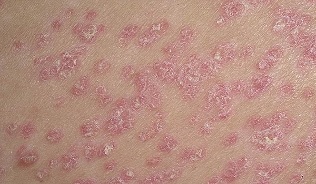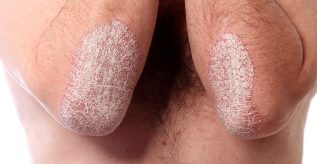When faced with psoriasis, many patients do not immediately recognize pathology as allergic rashes and other dermatitis. For the timely diagnosing of the disease, it is important to know how is the pathology, what are the stages of psoriasis and the symptoms of the disease at different stages. Of course of psoriasis is characterized by four phases, among which are primary, progressive, stationary phase and phase of decline. In more detail each of the stages, we believe that in this article.
In the initial phase of psoriasis

Many patients are interested in, how is the psoriasis at the initial stage? To see the first manifestations of the disease may be in the photo. This phase is characterized by the development of the skin characterized by red, pink dots with clear boundaries. The disease appears on different parts of the body. Here is a photo of the pathology in different parts of the body.
Symptoms of psoriasis in the initial phase of the
In the early stage of the disease is characterized by the following symptoms:
- slight peeling of the dermis;
- reddening of the skin;
- the development of itching;
- the feeling of dryness, tightness;
- the occurrence of spots of different diameters;
- the gradual strengthening of the peeling.
The clinical picture of the disease, which may vary depending on the type of disease. So, psoriasis in drops the size of the plate has a smaller diameter, not more than 2 — 3 mm. In the most common, vulgar, rashes remain high more than 5 cm, often aggregated together, forming a large lake. For pustular psoriasis is characterized by education on the dermis a yellow crust or gray with the accumulation of serous fluid under them.
The initial stage takes each patient differently. Depending on the type, the immune system of the patient, and the other characteristics of the organism.
Treatment in the early phase of the
For the first stages of the disease is often prescribed a topical treatment of lesions with the use of ointments, gels, lotions. Drug therapy is designed to eliminate the itching, flaking, swelling, redness, inflammation. If you want to do this, use of hormonal and non-hormonal ointments.
Hormones in the initial stage is prescribed rarely. Often their use is indicated in patients with acute course of pathology.
Hormonal ointments, which often cause side effects. It is recommended to use them only on prescription.
The progressive stage of psoriasis

The progressive stage is characterized by increased manifestations of the disease, panels are becoming more and more itching, peeling, swelling, inflammation increases. Rashes on the skin begin to blend together affect many areas of the dermis. In the progress phase, often appears this problem is a phenomenon kebnera. The essence of the phenomenon lies in the fact that new lesions occur in areas of injured skin. If the skin has scratches, abrasions, burns, in their place the probability that the display panels. The duration of progress phase lasts on average from 14 days to several months. In each patient, this period is depending on the individual characteristics of the organism and how quickly the immune system to cope with pathology.
Treatment of advanced stage
Acute psoriasis requires a holistic approach using the following methods:
- Of the medicinal product.
- The use of physiotherapy.
- The correction of way of life of the patient.
Important! Tactics of treatment is selected individually for every patient depending on the severity of the disease, peculiarities of its course and the presence of complications.
Medicines
To remove the plaque and reduce the symptoms in medical practice uses the following groups of medicines:
- Antihistamines – designed to reduce these symptoms, such as itching, redness.
- Sedative medications, which helps to remove excessive nervous tension and normalize sleep.
- Anti-inflammatory drugs - certainly relieve inflammation, help eliminate the redness and other signs of disease.
- Diuretics are medicinal products intended for excretion of excess fluids and salts. These medicines help clean the body, which have a positive impact on the course of the disease.
- Keratolytic – contribute to a good exfoliation for the epidermis, strengthen the regeneration of the dermis, update it.
- Immunomodulators – regulates the functioning of the human immune system, which is an important part of the treatment.
- Hormonal creams give quick results, they are used mainly in severe disease.
- Cytotoxic agents – tend to suppress the immune system, which is sometimes necessary for the elimination of the psoriatic plates.
All medicines should be used only after prescription. Self-treatment will only aggravate the course of disease.
Physiotherapy treatment
Methods of physical therapy include:
- PUVA therapy;
- The use of ultrasonic irradiation.
- Magnetotherapy.
- Selective therapy.
- The laser beams.
- Mud.
- Paraffin baths.
- The Spa treatment.
The number of sessions and their duration, as chosen by the physician according to the characteristics and type of disease, as well as the personal qualities and General well-being of the patient.
Traditional methods

Folk medical methods are recommended:
- Natural oils (juniper or lavender). Have a healing and calming effect, soothing effect on the skin. Method of application: a few drops of oil, add the cream and dot to put on the rash.
- Hydrogen peroxide (3%). Point is used and not washed. Before applying you should consult with a dermatologist.
- 30 g of propolis, mixed with 250 ml of vegetable oil (pre-boil). Prepared mixture used for dissolving the Horny layer of the epidermis and restore skin elasticity.
- Beeswax. This product is soothing. Beeswax should be melted in a water bath, then gently apply the crust, covering the papules.
- Med. The main waste product of bees has a positive effect on the human body for psoriasis. This should be consumed in limited quantities – 2 tablespoons per day.
Tincture against psoriasis
Of the popular treatment methods used for all the same oil and hydrogen peroxide.
You can add the tincture on the basis of celandine. For its preparation you will need 3 tablespoons of this plant (dried or fresh) and salt water. In any case, do not use alcohol, because this can dry up the skin.
How to prepare a remedy:
- components must be mixed together;
- leave for a few hours.
Before using the tincture of the skin, it is advisable to anoint the birch tar (dot) to increase the healing effect.
In order to treat effectively, the patient must go to the diet, harmful foods cause deterioration of the sheet.
Diet for psoriasis

Patients with psoriasis, it is important to follow a proper diet. Diet will quickly clear the skin from the platelets, prevention of complications of the disease.
The principles of clinical nutrition the following:
- It is necessary to abandon sharp, salty, sour, fried food. These products only increase the growth plates.
- The diet should be saturated with a lot of vegetables and fruits.
- The main dishes it is better to choose cereals, soups, lean fish and meat.
- On the table must not contain food allergens. You have to give up eggs, nuts, chocolate, citrus.
- Beverages with caffeine, which are also excluded.
- Prohibited alcohol, carbonated beverages.
- Dairy products should not contain fat. The advantage of yogurt without additives, kefir, yogurt.
It is recommended that we eat small portions avoiding overeating. Diet is an important part of the treatment of the disease. A proper diet helps to saturate the body with vitamins, to get rid of toxins.
The stationary phase
The stationary phase characterized by decline in the growth of psoriatic plates, and their number on the body is not reduced, the disease seemed to go into sleep mode. In the presence of precipitating factors, the pathology from the rest, you can again go to the stage progress. The reasons for this phenomenon has become improper treatment, refusal to diet, damage to the skin. The duration of the stationary phase are so different in different patients, which is very difficult to imagine. On average, it takes from a few weeks to several years.
Phase of the regression
Stage regression is the last step before remission of the disease. Here are the following changes:
- The colour of the papules of bright red passes in a bright, pink shade.
- Reduces the amount of peeling.
- It is the itching.
- The skin is cleansed, gets a smooth tone and structure.
- While some parts of the body are the so-called "duty panels". Such outbreaks are not completely retained on the skin, even during remission.
Psoriasis refers to a chronic dermatitis, non-infectious nature. To completely get rid of pathology is to date not possible. Patients who have a pathology, you need a life take into account preventive measures to prevent recurrence. Many patients are able to maintain remission for several years and live a full life.























